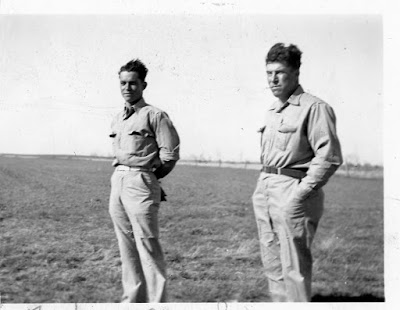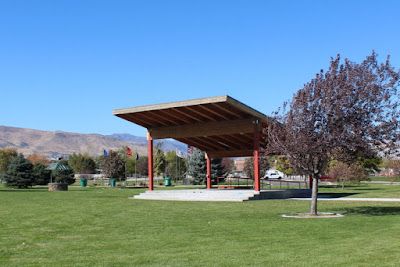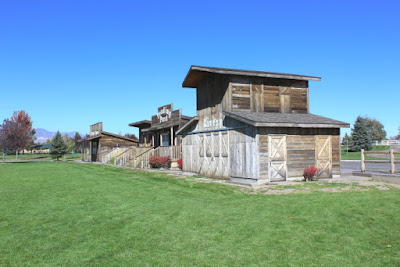Bluffdale (population 7,598) was a small little known community in Utah until the United States Government picked the town for the first Intelligence Community Comprehensive National Cybersecurity Initiative Data Center, commonly referred to as the Utah Data Center (UDC). I tried to visit the Center, but was turned away by an armed security guard because I did have authorization for a visit.
The UDC is a "massive data repository" for the United States Intelligence Community that is designed to store exabytes of data. One exabyte is ten to the 18th power computer bytes.
Cost to build the Center has been estimated to be $1.5 billion and an additional $2 billion was required for all of the electronic hardware that was installed to run the facility.
Based on aerial pictures, there are two main buildings on the site that are believed to contain at least 100,000 square feet of data storage space and 900,000 square feet of technical support and administrative space. Some information about the site is available on the web - there are two on-site power plants to supply the estimated required 65 megawatts of electricity needed to power the equipment. Electrical costs are estimated to cost about $40 million per year. Water usage for the power plants is estimate to be 1.7 million gallons per day.
The purpose of the UDC is classified, but it is known that the Center was built to support the Comprehensive National Cybersecurity Initiative (CNCI). The National Security Agency (NSA) manages the facility for the Director of National Intelligence. Code name for the Center is "Bumblehive."
A web article indicates the UDC is able to process "all forms of communication," but a NSA spokes person said "Many unfounded allegations have been made about the planned activities of the UDC....one of the biggest misconceptions about NSA is that we are unlawfully listening in on, or reading emails of, U.S. citizens. This is simply not the case."
According to one published source, "In April 2009, officials at the United States Department of Justice acknowledged that the NSA had engaged in large-scale overcollection of domestic communications in excess of the United States Foreign Intelligence Surveillance Court's authority, but claimed that the acts were unintentional and had since been rectified.
Camp Williams Army Post is located directly across the road from the UDC and is used as a training facility for the Army National Guard.
The Utah National Guard was originally formed as the Utah Territorial Militia and it was known as the Nauvoo Legion. Men between the ages of 18 and 49 were recruited to protected travelers on the Central Overland Route that ran through Utah.
In later years the Legion was called to serve in the Utah War, Black Hawk War, and Walker War. Then, in 1887 the Legion was abolished by the Edmunds-Tucker Act and the Utah Army National Guard was established in its place.
In 1915 President Woodrow Wilson set aside 18,700 acres of Federal land as a permanent training ground for the Army National Guard. The Post was named after Brigadier General William Grey Williams in recognition of his leadership in the Spanish-American War.
Just down the road from Camp Williams is the Utah Veterans Cemetery and Memorial Park.
Just down the road from Camp Williams is the Utah Veterans Cemetery and Memorial Park.
Cemetery burial plots are located in manicured grounds that overlook the Wasatch Mountains and there is a chapel with a five-story vaulted ceiling that will accommodate 150 guests for military services. Also located on the grounds is a memorial to the submarine crew of the USS Harder.
The USS Harder set a submarine war record for sinking five Japanese Destroyers in five days and was credited with sinking 78,000 tons of Japanese shipping before being lost on August 24, 1944.
As part of the Memorial there is a Model 3A MK.XIV Torpedo on display that when active had 600 pounds of explosives in the warhead and weighed 3,185 pounds. The torpedo is 21-feet long, has a diameter of 20.5 inches, and a maximum speed of 55 miles/hour for a distance of 4,500 yards, or 36 miles/hour for a distance of 9,000 yards.
Since I am a veteran, the cemetery administrator told me that I could "drop-in" for a stay anytime. I informed her I was really busy, so I would have to take a raincheck for the invitation.
Bluffdale has a fairly new City Center located in a large city park that contains playground equipment, a pavilion for concerts, concession stand, a veterans memorial, and a rodeo arena. The Veterans Memorial was constructed as a Boy Scout Eagle project.
Several years ago I unsuccessfully spent several hours trying to find historic Fort Herriman based on some vague directions, but finally gave up. Since I was in the area, I put the Fort's name in my GPS unit and drove right to the site. Technology is amazing!
Fort Herriman was build in 1855 to protect settlers against Indian attacks in the area. However, there were never any Indian attacks, so under instructions from Brigham Young the Fort was abandoned in 1858. Now all that is left of the fort is a stone marker.
While driving back to the Interstate from the Fort Herriman site, I passed through the City of Riverton (population 44,419) and noted an unusual looking building in the Riverton City Park. The building had a copper roof that really glistened in the sunlight. I wanted a better look at the building; so I decided that I had better turn around and go back, which was no easy task because I was driving Heather's Armada. (Nicknamed "The Queen Mary" because of its size and maneuverability.)
City people working in the building explained that the structure was a recent reproduction of the historic Dome Church and the new building is used as a community center. The original Dome Church building was designed by Carl Madsen Bradt who was born at Randers, Randers Kommune, Midtjylland, Denmark in 1857.
On display in the building is the original chapel organ that was manufactured by the Packard Organ Company in Fort Wayne, Indiana. The organ was purchased in 1907 for $250, shipped to Riverton, and installed in the Dome Church, which at that time was located on Redwood Road. The organ was equipped with the largest set of reeds that Packard installed into a manual church organ at that time. Some of the windows from the original Dome Church are displayed along the walls of the building on the second floor.
And, when I visited they just happened to be having a quilt display!
Also located in the park, directly across from the Community Center, was a nice skateboard facility for use by the younger generation. .
Since I am a veteran, the cemetery administrator told me that I could "drop-in" for a stay anytime. I informed her I was really busy, so I would have to take a raincheck for the invitation.
Bluffdale has a fairly new City Center located in a large city park that contains playground equipment, a pavilion for concerts, concession stand, a veterans memorial, and a rodeo arena. The Veterans Memorial was constructed as a Boy Scout Eagle project.
Several years ago I unsuccessfully spent several hours trying to find historic Fort Herriman based on some vague directions, but finally gave up. Since I was in the area, I put the Fort's name in my GPS unit and drove right to the site. Technology is amazing!
Fort Herriman was build in 1855 to protect settlers against Indian attacks in the area. However, there were never any Indian attacks, so under instructions from Brigham Young the Fort was abandoned in 1858. Now all that is left of the fort is a stone marker.
While driving back to the Interstate from the Fort Herriman site, I passed through the City of Riverton (population 44,419) and noted an unusual looking building in the Riverton City Park. The building had a copper roof that really glistened in the sunlight. I wanted a better look at the building; so I decided that I had better turn around and go back, which was no easy task because I was driving Heather's Armada. (Nicknamed "The Queen Mary" because of its size and maneuverability.)
City people working in the building explained that the structure was a recent reproduction of the historic Dome Church and the new building is used as a community center. The original Dome Church building was designed by Carl Madsen Bradt who was born at Randers, Randers Kommune, Midtjylland, Denmark in 1857.
On display in the building is the original chapel organ that was manufactured by the Packard Organ Company in Fort Wayne, Indiana. The organ was purchased in 1907 for $250, shipped to Riverton, and installed in the Dome Church, which at that time was located on Redwood Road. The organ was equipped with the largest set of reeds that Packard installed into a manual church organ at that time. Some of the windows from the original Dome Church are displayed along the walls of the building on the second floor.
And, when I visited they just happened to be having a quilt display!
Also located in the park, directly across from the Community Center, was a nice skateboard facility for use by the younger generation. .
BONUS HISTORICAL PICTURES
My Father, Eldon, had two brothers - Milo and Ormel.
My Father, Eldon, had two brothers - Milo and Ormel.
 |
| Milo, Jepson (Their Father), Eldon, Ormel |
 |
| Ormel and Milo |
Milo ran a radio shop in Coffeyville, Oklahoma, and was an avid short wave radio operator. He had his own station with call letters W5EAK. He also had a mobile unit in his car and on the car's back bumper he had installed a really tall antenna. When I was young it seemed like the antenna was about 50 feet tall, but in reality it was probably only about 15 feet.
I remember when he would sign on to the short wave network, he would say "This is W5 Eggs, Apples & Kraut." As kids, we really thought that was funny.
Milo's first wife Opal passed away when she was 43 years old. They did not ever have any children. He remarried, but did not have any children with his second wife Edna either. In his obituary it says that he had a stepdaughter, but I did not ever meet her. I do not even know her name. Someday I'm going to see if I can find out more about her.
 |
| Milo |
Ormel was on an air crew during World War II. Because airplanes were not pressurized, and it was really cold when flying, he had some amazing artic gear that he wore to keep warm. When Ormel came home from the War he was able to keep all of his clothing and artic gear, which he often needed to survive the South Dakota winters.
After the War ended Ormel went back to farming; but after my father passed away, he moved into Blunt, South Dakota, where he had various jobs. He did not ever marry.
Ormel really liked fishing and it was fun to go with him because he knew how to catch more than Bullhead Catfish. Bullheads were easy to catch, and they were plentiful in every stock dam, so this is type of fish we kids typically caught.
I remember before the Oahe Dam was completed, Ormel would take us to Arikara Lake, which was straight west of our country school house. It was a little scary getting to the main part of the dam because you had to drive over a really high wooded bridge that would creak and shake while you were crossing. The County finally closed the bridge to vehicle traffic, but you could still walk across the bridge to the lake. There were some trees along the west side of the dam and it was a good place to catch Croppies. My older brother told me that a number of years ago the lake was drained and the dam was removed.
After the Oahe Dam was completed on the Missouri River, that became the favorite place to fish for Walleyes and other game fish.
 |
| Ormel |










































No comments:
Post a Comment